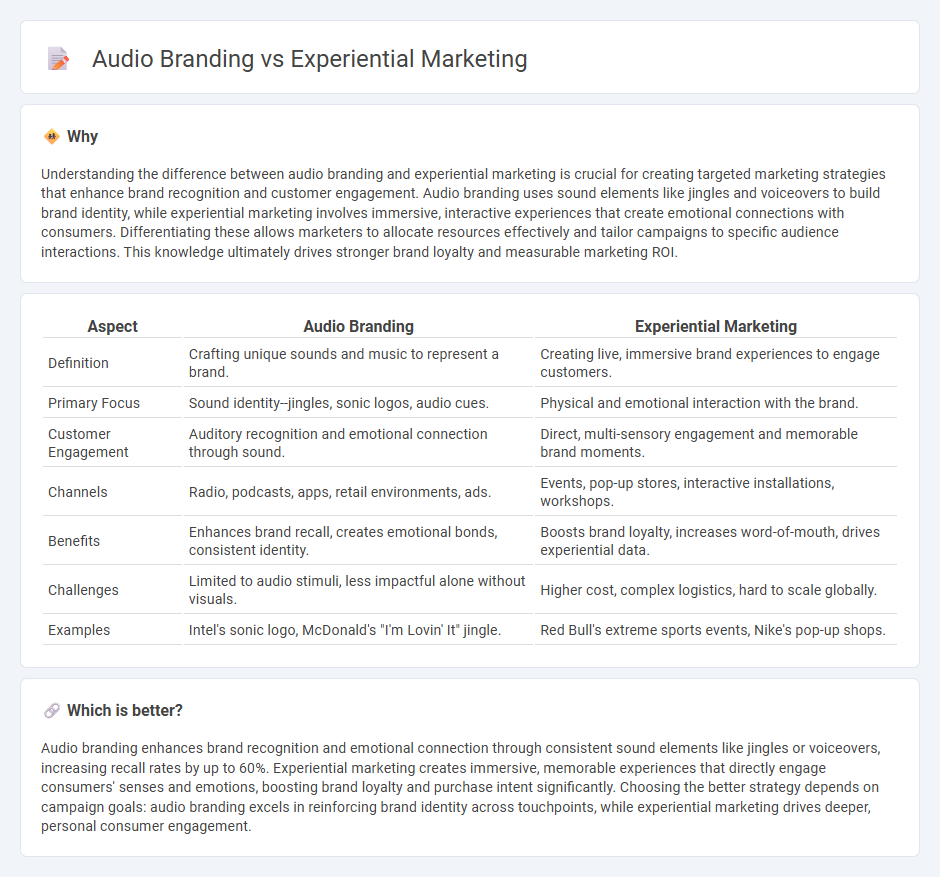
Audio branding uses distinctive sounds or music to create a memorable brand identity that enhances customer recall and emotional connection. Experiential marketing engages consumers through immersive, interactive experiences that foster deeper brand loyalty and direct customer involvement. Explore how combining audio branding with experiential marketing can elevate your brand's impact.
Why it is important
Understanding the difference between audio branding and experiential marketing is crucial for creating targeted marketing strategies that enhance brand recognition and customer engagement. Audio branding uses sound elements like jingles and voiceovers to build brand identity, while experiential marketing involves immersive, interactive experiences that create emotional connections with consumers. Differentiating these allows marketers to allocate resources effectively and tailor campaigns to specific audience interactions. This knowledge ultimately drives stronger brand loyalty and measurable marketing ROI.
Comparison Table
| Aspect | Audio Branding | Experiential Marketing |
|---|---|---|
| Definition | Crafting unique sounds and music to represent a brand. | Creating live, immersive brand experiences to engage customers. |
| Primary Focus | Sound identity--jingles, sonic logos, audio cues. | Physical and emotional interaction with the brand. |
| Customer Engagement | Auditory recognition and emotional connection through sound. | Direct, multi-sensory engagement and memorable brand moments. |
| Channels | Radio, podcasts, apps, retail environments, ads. | Events, pop-up stores, interactive installations, workshops. |
| Benefits | Enhances brand recall, creates emotional bonds, consistent identity. | Boosts brand loyalty, increases word-of-mouth, drives experiential data. |
| Challenges | Limited to audio stimuli, less impactful alone without visuals. | Higher cost, complex logistics, hard to scale globally. |
| Examples | Intel's sonic logo, McDonald's "I'm Lovin' It" jingle. | Red Bull's extreme sports events, Nike's pop-up shops. |
Which is better?
Audio branding enhances brand recognition and emotional connection through consistent sound elements like jingles or voiceovers, increasing recall rates by up to 60%. Experiential marketing creates immersive, memorable experiences that directly engage consumers' senses and emotions, boosting brand loyalty and purchase intent significantly. Choosing the better strategy depends on campaign goals: audio branding excels in reinforcing brand identity across touchpoints, while experiential marketing drives deeper, personal consumer engagement.
Connection
Audio branding enhances experiential marketing by creating immersive sensory experiences that strengthen brand recognition and emotional engagement. Integrating signature sounds, jingles, or sonic logos into physical or digital environments amplifies consumer interaction and recall. This synergy elevates brand identity through multisensory storytelling, driving deeper customer loyalty.
Key Terms
**Experiential Marketing:**
Experiential marketing creates immersive brand experiences that engage consumers through physical interactions, events, and sensory activations, fostering deeper emotional connections and lasting brand loyalty. It leverages multi-sensory stimuli, such as touch, sight, and sound, to create memorable moments that drive consumer engagement and word-of-mouth promotion. Explore how experiential marketing strategies can transform your brand presence and customer relationships.
Immersive Experience
Experiential marketing creates immersive brand interactions by engaging multiple senses, fostering deep emotional connections and memorable consumer experiences. Audio branding specializes in crafting distinctive sound identities that enhance brand recognition and reinforce messaging across touchpoints. Discover how combining these strategies can transform your brand's immersive experience.
Brand Engagement
Experiential marketing leverages immersive, multi-sensory events to create memorable brand interactions, driving emotional connections and active participation from consumers. Audio branding uses consistent soundscapes, jingles, and sonic logos to reinforce brand identity and enhance recall through auditory stimuli. Explore how combining these strategies can elevate your brand engagement to new heights.
Source and External Links
What Is Experiential Marketing? - Limelight Platform - Experiential marketing is a strategy that engages consumers through live, immersive experiences that turn passive audiences into active participants, building emotional connections and providing tangible interactions with brands through events, pop-ups, demos, and sponsorships.
Engagement marketing - Wikipedia - Experiential marketing involves creating custom memorable physical and interactive experiences that engage customers emotionally and sensorily, helping brands differentiate themselves and fostering loyalty through meaningful brand-consumer interactions.
What is experiential marketing? Definition and examples - Amazon Advertising - Experiential marketing connects brands with consumers through experiences like pop-up stores, virtual events, and interactive installations designed to be memorable, engaging, measurable, and aligned with brand identity and marketing goals.
 dowidth.com
dowidth.com